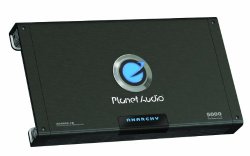$159.99
$159.99
(SAVE Now!)
as of 04/19/2024 (Details)
View larger Class D Topology A class-D amplifier or switching amplifier is an electronic amplifier where all power devices (usually MOSFETs) are operated as binary switches. They are either fully on or fully off. Ideally, zero time is spent transitioning between those two states. In this way, power loss is significantly reduced and making a D class amplifier anywhere from 75% to 95% efficient To maintain high efficiency, the filter is made with purely reactive components (inductors and capacitors), which store the excess energy until it is needed instead of converting some of it into heat. Some other advantages include Reduction in size and weight, Reduced power waste as heat dissipation and hence smaller (or no) heat sinks and Reduction in cost due to smaller heat sink and compact circuitry. MOSFET PWM (Pulse Width Modulated) Power Supply Metal–Oxide–Semiconductor Field-Effect Transistor is a transistor used for amplifying or switching electronic signals. We use it in billions of them. In our computers, our telephones, game consoles, cars, electrical appliances and in this case, our Amplifiers. They are found in systems where information is processed or stored. A MOSFET is basically an electrical switch that allows the flow of electrical current. An electrical switch has two possible states, ON or OFF. This is where the MOSFET performs its most important role in our D Class amplifiers by allowing or preventing the flow of power and creating an efficient amplifier. The “Pulse Width Modulated” is a design that is significantly simplifies power supplies. It controls the output voltage and current precisely by not only removing the output current sensing loss, but also eliminating all secondary feedback circuitry. The PWM can increase efficiency, is lighter, smaller, can reduce total cost, productivity and system reliability. View larger Variable Phase Shift This function on the amplifier comes in handy for custom installations where you might need to have your speakers or subwoofers mounted the non-traditional way with the magnet facing out. Let us explain. You can set the Phase anywhere from 0 degrees to 180 degrees. What this does is that it reverses the polarity (Positive/Negative) on your subwoofer terminals which in turn reverse the direction of the low frequency BOOM that you are used to hearing. View larger Variable Low-Pass Crossover Subwoofers reproduce sound based on a number of different low-range frequencies. This process is called the crossover effect and occurs because the vast majority of audio systems cannot cover the entire spectrum sufficiently to minimize sound distortion and maintain an appropriate frequency ratio. In the case of our AC5000.1D amplifier, a variable crossover is offered so that you, the listener, can have the ability to set the frequency at which the crossover occurs, thereby setting specific sound specifications for the bass frequency reproduction. View larger Low Level Inputs With Pre-Amp Outputs A low level input is measured in volts. It comes in the form of RCA (low level) outputs on the back of your head unit and goes to the RCA inputs on your amplifier (Right/Left). With that in mind, you can take control of more power by connecting more amplifiers together using the RCA pre-amp outputs (Right/Left) from your primary amplifier straight to the RCA inputs of a second or satellite amplifier (Right/Left). View larger Variable Subsonic Filter Subwoofers start to bottom out trying to reproduce low-frequency signals that are below their abilities to sound off. Bottoming out is more a mechanical problem and happens when the subwoofer driver reaches the limit of its excursion and creates a clacking or flapping sound instead of the low frequency entering its voice coils. If your sub is bottoming out, short of changing the driver into one that has better low-frequency handling, you can try the AC5000.1D which has a subsonic filter to filter out frequencies below its specified low frequency limits. View larger Variable Bass Boost (0 to +18 dB) So you have Bass Boost and Variable Bass Boost. The difference between the two is that with Bass Boost you either have extra bass or you don’t. But with Variable Bass Boost you have the control of exactly how much BASS you want to pump out to your subwoofer(s). And this is what you get with the AC5000.1D Amplifier. Variable Bass Boost. View larger Strapping Capable This sounds like exactly what you might be thinking. You are able to strap your AC5000.1D amplifier to another Anarchy class D amplifier and double the power that is being sent to your subwoofer(s). You now have the ability to connect more subwoofers to take advantage of the extra power.
Technical Details
- Switchable Input Sensitivity: 100mV-2V or 2V-8V
- Switchable Phase Shift (0-180º)
- Variable Bass Boost (0 to +18dB)
- Continuously Variable Low Pass Crossover
- Strapping Capability: Strap two amps together for twice the power
